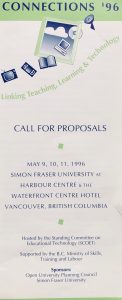Flashback Friday – mid-90s
…another cool thing about the Net is that you can use it to publish not just words and pictures, but also music.”
Happy 2019 ETUG! This is the first post of many that take a nostalgic look back at ETUG’s long and storied history. We will showcase highlights of what happened that year in pop culture, tech trends—the hits, the misses–and the ETUG hijinks that everyone was talking about then, and still do. Away we go! It’s back to when it all began: ETUG, the fledgling years, 1994, 1995 and 1996.
ETUG started in 1994 with the meeting up of three grassroots user groups from the B.C. public post-secondary institutions:
- Interactive Videoconferencing User Group
- Computer-mediated communication Group
- Mullti-Media User Group
Back then, members would meet to network, share stories and trouble-shoot on such cutting edge topics as the latest technology, computers, tools and gadgets, video and audio conferencing best practices, internet training, email etiquette, compatibility and interconnectivity, services for leaners in remote area, and planning the shift from analog to digital tools.
- Pop Culture: 1994 Oscar Winner Best Picture: Schindler’s List; 1995 Oscar Best Picture: Forrest Gump; 1996 Oscar Best Picture: Braveheart.
- Hot Technology Topics: 1994 was the year the World Wide Web was born, a.k.a. the Internet as we know it today. A 2014 Business Insider article gives insight into what tech life was like then: “No Google. No Netflix. No iPhone. This is what Tech was like in 1994″.
 Fast forward to 1995, and many people’s favourite use of the internet was checking email! The phrase “Cruisin’ the Internet” was coined around this time. Can you spot two long time ETUG members in the opening sequence of the cruisin’ video?
Fast forward to 1995, and many people’s favourite use of the internet was checking email! The phrase “Cruisin’ the Internet” was coined around this time. Can you spot two long time ETUG members in the opening sequence of the cruisin’ video? - Workshop Topics: A collaboration of the three user groups resulted in Connections ’96: Linking Teaching, Learning and technology. Held at SFU Harbour Centre and the Waterfront Hotel, conference sessions included such topics as new models for teaching and learning, video conferencing, the Internet and World Wide Web, multimedia, computer use in education, distance education, and instructional support.

